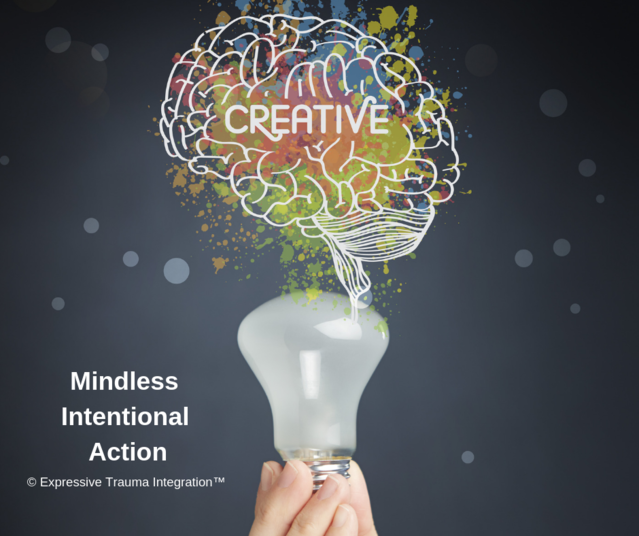Mindfulness
Why You Should Be Mindless in 2019
Mindfulness and Mindlessness After Trauma
Posted December 31, 2018
One of the most dismaying results of trauma is that it often takes away from survivors things that are precious to them that have no apparent connection to the original event. I learned much more about this than I would wish for anyone in the long, hard desert that entered my life after my brother died suddenly in his thirties nearly two decades ago.
Up until that time, dance had been an important part of my life. No matter how difficult things may have been, I felt grounded when I danced. Now I was so overwhelmed with grief that for several years I didn’t even try.
When I finally gained the strength to make a first effort, I discovered that something in me had changed. I had lost the inner rhythm and joy that in the past always rose up strongly at the intersection of sound and movement.
I sought healing - therapies of various kinds, partying with friends, dance classes, hanging out at dances, listening to music – but nothing helped for over a decade. In this blog post I write about how mindful movement eventually helped me to regain my rhythm.
Although I only came to understand this much later, the free-form dance that I loved increased my sense of joy because it is a form of a spontaneous (mindless) action. When a dancer relaxes control - lets go of the monitoring, evaluating, planning and coordinating that fill our minds from morning to night - and lets rhythm lead, music and movement fuse with a wonderful energy.
Trauma drives threat and fear so deeply into the heart of a survivor that it takes very little to trigger panic. The threat may be real or, often, existing only in our perceptions. Either way, a strong need to stay in sense of control invades the life of most survivors.
This mechanism is survival-based and instinctual. As such, in any moment that it is triggered, it often dominates any other responses we might normally be capable of. It’s a reaction, not an aware choice, an important point I’ll return to for it offers a way out of the problem. (stage #3 ETI Roadmap).
I call this early stage in the after trauma roadmap Withdrawal, for its primary intention is to prevent further harm. Withdrawal is a secondary defense mechanism, active after the moment of fight/flight/freeze is past, that ensures survival by reducing vulnerability to further injury.
Think about yourself just after you’ve had an injury, a big argument, or even just a startle. You probably don’t rush off into a new adventure. Rather you step back and regroup inwardly, you calm yourself, you go to a safe place and rest. There are many forms of withdrawal, some as short as a few seconds, others decades in length.
Awareness is key to moving beyond withdrawal
Three types of awareness are particularly useful in moving beyond the hair trigger reactivity that often troubles us in the withdrawal stage. (Withdrawal stage #3 in the ETI roadmap). The first is information about how trauma affects the brain. See my blogpost on psychoeducation for more on this.
A second type of awareness especially useful to trauma survivors is being in the present, or mindfulness. Kabat-Zinn says, “Mindfulness is awareness that arises through paying attention, on purpose, in the present moment, non-judgmentally.”
In trauma therapy, we help survivors to become mindful of their body and its signals. The benefits of mindfulness are many, including increased capacity to self-regulate. However, caution is in order. Mindfulness is challenging for trauma survivors since, along with awareness of the present can come expanded awareness of sensitivity to certain sounds, smells, or textures. These sensitivities, known as triggers and alerts, torment many survivors by bringing to the surface unwanted memories and a flood of emotions. If not developed slowly and gradually, mindfulness can cause more harm than good.
Grounding is a form of body-awareness
A third type of awareness is body-awareness. A technique for this is Grounding, which is also a valuable entry point to begin the practice of mindfulness. Grounding can be achieved through a variety of techniques for being aware of and present in the body such as: pressing a foot against the floor and noticing how it feels while touching the floor, or walking barefoot on sand or carpet and noticing how it feels. See this blog post for more information and examples.
Creativity and playfulness merge in intentional mindlessness
While mindfulness is essential for establishing self-regulation - a key requirement for trauma integration - it is not enough. To engage with all aspects of wellness, survivors need to reconnect to spontaneity since it’s essential to the experience of joy. A powerful strategy for this is what I call intentional mindlessness. When we engage in mindless action, whether playing sport or other games, dancing, drawing, hiking, singing or playing music, or any other activity that absorbs us in a fun and playful way, our spontaneity increases.

A simple concept I repeat often in classes, trainings and therapy is this: If trauma is a frozen moment in time, then spontaneity is the antidote. The more we can engage in spontaneous actions the more we are able to experience joy in our lives.
Add mindlessness to increase joy? Yes! Mindlessness that incorporates creative activity can be just as calming to the nervous system as mindfulness and engaging in it enhances ability to be spontaneous. While we need mindfulness to be in the present and expand capacity to tolerate the discomfort that comes with trauma stress responses, we equally need to be able to be mindless, without wandering into anxiety, stress and rumination.
Not all mindless actions are equal
According to Metzinger (2018) we engage in mindlessness (mind wandering) several hundred times a day and up to 50 percent of our waking life. However often it is an unhelpful form. Rumination, for example, is a common form of mind wandering in which we get into cyclic negative thinking and worrying about certain situations.
Seli et al., (2015) have found that when mind-wandering is not intentional the response to internal experiences is negative. But, when mind-wandering is intentional the internal experience brings positive associations.
So in practicing intentional mindlessness, we want to engage in activity that fully absorbs us (and while we are doing it the mind for the most part doesn’t wonder to other thoughts or to what we are thinking and feeling).
In some ways the intentionality of mindlessness resembles that of mindfulness. The key difference is that mindfulness focuses on awareness of what is here and now (sensations and feelings, thoughts), whereas mindlessness focuses on an task or activity. Like any other ability or discipline, it takes practice to learn mindlessness and enjoy its benefit. The more we practice the more we benefit from it.
Examples of intentionally mindless activities include:
- Playing games (not video games)
- Exercise and sport activities (emphasis on cardio)
- Scribbling and doodling
- Dance and movement
- Singing or listening to music
- Cooking/baking
As with so many aspects of trauma integration, there are multiple pathways available other than grounding or intentional mindlessness. I give the above as examples that I know work for many. You probably know other activities that you used to enjoy as a kid, or activities later in life that were playful, calming, and enjoyable.
The goal is not to introduce a particular activity into the life of a trauma survivor. Rather it is to help establish routines that bring joy and creative energy back into life. What I like about the routines above - and this is important in order to sustain them long-term - is that they do not require the assistance or cooperation of others, they are inexpensive, and you don’t need to have a high level of skill or training.
I hope that 2019 brings you lots of intentional mindlessness in the form of play, creativity, and movement!
References
Baird, B., Smallwood, J., Mrazek, M. D., Kam, J. W., Franklin, M. S., & Schooler, J. W. (2012). Inspired by distraction: mind wandering facilitates creative incubation. Psychological science, 23(10), 1117-1122.
Metzinger, Thomas. (2018). Are you sleepwalking now?. Aeon online Magazine.
Seli, P., Carriere, J. S., & Smilek, D. (2015). Not all mind wandering is created equal: Dissociating deliberate from spontaneous mind wandering. Psychological Research, 79(5), 750-758.




